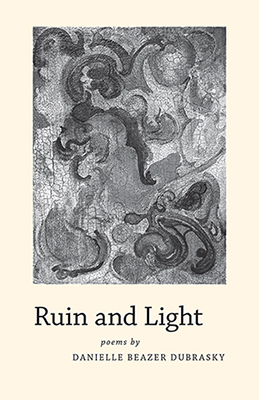
Ruin and Light
by Danielle Beazer Dubrasky
19 Poems/ 22Pages/ $8.00
Anabiosis Press
www.anabiosispress.org
Reviewed by: Ed Bennett
The power of poetry springs from its earliest forms, the prayers recited and handed down from one generation to another. These prayers dared to do the impossible - to join the material world of primitive peoples with their perception of the Divine. This conjugation of perception and belief gave rise to imagery, the one characteristic that gives spoken word the ability to create meaning beyond the reality of the immediate environment.
Danielle Beazer Dubrasky’s Ruin and Light is a collection of poems that harkens to the original poetry of millennia past by the deft use of imagery. The poems are almost hymnal in their structure, calling out the religious songs of the Ancient Greeks while injecting images taken from both Pagan and Christian traditions. To be honest, I was unsure if this was a collection of poems on a similar theme or of a single work slowly exposing an ancient myth. This is meant in the highest regard, since the lines combine to form a cohesive story (“plot” seems too technical a word for this) of love and loss.
An example of Ms. Dubrasky’s imagery:
“All things she loved rose from your throat’s chords –
salt in a mollusk shell, the compass of an antler chip,
and the nights where the children who have never heard rain
returned pieces from the place they were lost –
severed bone made whole or a shell’s hinge
sealed over the creature brought home again.”
Seashells, especially mollusk shells have appeared in religious myth across the ages and the geography of our world. Venus, goddess of love, was born of the sea and one of her most famous depiction in Western art is Sandro Botticelli’s “Birth of Venus” where she appears on an abalone shell. The poet deepens the image with the mention of a mollusk shell. This shell was used in the Afro-Brazilian culture, primarily among Yoruba people, as a device to bridge the terrestrial world with the gods. The mention of a “shell’s hinge” covering the creature brought home is an indication of the bridge, or hinge, between both worlds. The antler chip likewise has a dual image: In Celtic traditions, the deer is perceived as both gentle, a sign of love, as well as a protector. This same image is found in the western canon of saints where it appears with St. Giles and St. Hubert.
Reading these poems, especially paying attention to the images, educes another story beyond one of a generic love. The second poem in this book states
“Your sinews of voice trace ruin and light on her palm…
Each of your notes on her skin a moth singed by a star”
A lover’s voice seems to be predicting both ruin and redemption, but what of this? The image of music notes and moths is repeated yet again until the story becomes clear:
“What if you both break all the rules of this story
And she says I will never leave you and you say I will not look back.”
Woven like the golden threads in an embroidered scene we see the myth of Orpheus and Eurydice emerge. This occurs halfway through the book and it is at this point that the story of Orpheus becomes more obvious while it is interspersed with the other images mentioned previously. The images coalesce into the love story of Orpheus and Eurydice and one of the lesser images “children who have never heard rain”. Biblical images of rain usually connote renewal, a somewhat different interpretation of older images that denoted sadness. Orpheus and his love are together at the end of Ms. Dubrasky’s work, along with the images so intricately placed throughout. Her last lines are:
“You listen to the note only you have heard on the sinews of her voice,
A vibration of music so exquisite you must open your eyes –
Your fingers hold moth wings burning in starlight.”
Ruin and Light is a beautifully crafted book. The story is familiar yet it is elegantly told. This review brought out just a few of the images in the book but there are others also perfectly enmeshed in this story of love and tragedy. As with exceptional poetry, reading this book several times strengthens the plot and the reader is drawn even more deeply into this ancient love story. Yes, by all means, read the story in Ovid’s “Metamorphoses” but do not miss the beauty and the skill of this modern day telling in Ruin and Light by Danielle Beazer Dubrasky.
|


